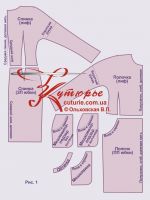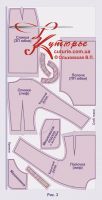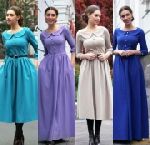Size charts What is the height of the pattern Payment methods Ask a question Reviews
 PDF pattern of a dress for printing on a printer or plotter in full size on sizes 40 to 54. Can be printed on standard sheets of paper from A4 to A0.
PDF pattern of a dress for printing on a printer or plotter in full size on sizes 40 to 54. Can be printed on standard sheets of paper from A4 to A0.
 Free download instructions on how to sew a kimono dress for a pattern ...
Free download instructions on how to sew a kimono dress for a pattern ...
How to sew a straight summer or winter dress with your own hands according to a pattern
Read this guide for beginners:
- Style and set of patterns for a straight kimono dress.
- From what to sew a summer dress or winter dress.
- How to download and print dress patterns with your own hands.
- How to cut a dress according to a finished pattern:
- How to sew a straight cut dress for beginners step by step after cutting.
Download the pattern of this straight dress
Description of a set of patterns and style of a straight kimono dress
Dress straight summer or winter depending on the fabric you choose for sewing
File format: PDF file for printing a pattern with your own hands of a straight cut-off kimono dress with pockets for sizes 40 to 54 life-size without seam allowances.
The PDF file of the pattern is designed for printing at home on sheets of paper of any size.
After paying for the order, you will receive links to download two dress pattern files for all sizes:
- PDF file adapted for printing patterns on sheets of A4 paper.
- PDF file for printing on sheets of any size from A0 to A4 on a printer or plotter using Adobe Reader.
Assembly diagram of a dress pattern when printing on A4 sheets of a home printer
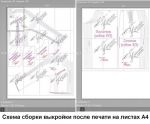 The pattern is assembled on two large pages of patterns from 32 A4 sheets:
The pattern is assembled on two large pages of patterns from 32 A4 sheets:
The first page of patterns - 20 A4 sheets, 4 rows of 5 sheets in a row.
The second page of patterns - 12 A4 sheets, 3 rows of 4 A4 sheets in a row.
Sewing difficulty level:
- Simple for beginners - with dovyaz cuffs;
- Medium - with tuning facings.
A set of patterns for sewing a straight cut-off kimono dress with pockets
- Back - bodice and RFP skirts.
- Shelf - bodice and PP skirts.
- Burlap valance for a skirt without a tuck.
- Burlap valance for a skirt with a tuck.
- Burlap-turning.
- Pocket lining.
The patterns of the remaining facings are not included in the kit, since in the process of trying on the neck line can be changed, and the sleeve is narrowed. In addition, the facing can be easily replaced with stripes of dovyaz - it will look the same, and sewing will become accessible to beginners.
This dress does not have a chest tuck, so the model is not recommended for girls and women with large breasts.
If you need a free silhouette, waist tucks can be left out. An option with a short one-piece sleeve is provided.
What to sew a winter or summer dress with a straight cut-off kimono with a sleeve
Knitted stretch fabrics with medium or high stretch are most suitable for sewing this dress.
For a winter or demi-season dress, a cooler and a footer are ideal.
Of course, thin girls with small breasts can choose inelastic knitwear.
For a simple processing of the neckline, the bottom of the sleeve and the pocket, it is recommended to use ordinary cuff knitwear (dovyaz, cuff), corresponding to the thickness of the knitwear from which the dress is sewn.
For summer straight dress with a short one-piece sleeve linen, poplin, thin denim, dress satin and chintz are suitable. Staple and silk fabrics can be considered less suitable due to the large wrinkling.
 It is worth noting that "stable" fabrics today can also be combined with a "cuff".
It is worth noting that "stable" fabrics today can also be combined with a "cuff".
Stretch velvet and stretch plush can also be attributed to less suitable ones, since under outerwear, due to the direction of the pile, the sleeves can be pulled up or twisted. For these fabrics, it is better to narrow the sleeve to the bottom along the arm.
Only highly stretchable knitted fabrics with a mandatory correction of the length of the bodice during the fitting remain for the happy owners of a magnificent bust.
Fabric consumption for sewing according to the pattern of a straight dress with a sleeve
Fabric consumption is 150 - 170 cm with a width of 150 cm.
The cuff fabric consumption is about 25 cm. The companion fabric consumption is up to 35 cm.
How to download, print and assemble a dress pattern with your own hands
How to choose a pattern size without taking measurements and use of tables.
How to print a life size pattern on sheets of A4 - A0 format.
How to assemble a pattern after printing.
Ready-made patterns of dresses in full size free download.
Download this straight cut dress pattern
How to cut a straight cut-off kimono dress according to a finished pattern with your own hands
The choice of the desired size in the finished printed pattern in this case depends on several parameters. It is easier to proceed from the volume of the hips and the properties of the fabric:
- For example, knitwear with high stretch can be used to make a tight-fitting dress. In this case, we choose the size in which Pb (an increase in the hips) will be 1 - 2 cm.
- For a linen dress (with a short sleeve kimono), we choose a freer size - Pb = 2 - 4 cm.
- For a staple dress (also only a short one-piece sleeve), it is advisable to increase the PB to 6 - 8 cm. You will get an oversized dress, the waist seam of which we will stitch with rubber threads and will be worn with a wide belt.
Features of cutting facings in the sleeves of the dress, collar and pocket
Separately, it should be said about the facings of a contrasting color, which you see on photo of this straight dress.
This is a tuning facing, which is literally adjusted to the face of the product. Processing will require ironing the tuning cut on the template, which must first be bent. For ironing, you will have to make cardboard facing templates (picture 2) according to the patterns of the shelves and backs.
For a sample, we take a pattern for turning a pocket. To make a template for the bottom of the sleeve, we fold the patterns of the back-shelf sleeve to the sleeve, and for the neckline - with shoulder cuts.
We circle exactly along the cut, retreat along the width of the pocket facing or at our discretion. Then, we draw the line of the trim cut and cut it out.
According to the same templates without seam allowances, dubbing for tuning facings should be cut.
Seam allowances for a straight kimono dress with pockets
The seam allowances for the trim facings for the trim cut, which must first be bent and ironed, are 1–1,2 cm. And from the side of the concave cut – the neckline and the entrance to the pocket – 0,5 cm.
For processing accuracy, the same allowances should be repeated on the concave sections of the front and back. These are cuts of the neck and sprout, as well as a cut of the entrance to the pocket on the skirt and burlap-turning.
For tuning stitching along the bottom of the sleeve, the exact width of the allowance does not matter much - we take 1 - 1,2 cm from all sides.
We do not add an allowance along the waist section of the skirt.
The remaining allowances are 1 cm, with the exception of the bottom of the skirt and the bottom of the bodice.
At the bottom of the skirt for a hem with an open cut (single hem with or without preliminary overcasting for knitted fabrics), add 2,5 - 3 cm.
Closed hem (double hem for cotton or linen fabrics) 3 - 4 cm.
How to adjust the bodice of a dress during a fitting
Separately, it should be said about the waist allowance for the bodice. This allowance is needed to correct the length of the bodice for fitting. This correction allows you to determine the exact position of the waist line, based on the characteristics of posture and other parameters of the figure.
So, for example, in a stooped girl with small breasts, the bodice will become shorter in front and, possibly, longer in the back than it was originally. And for a girl with large breasts and good posture, the bodice will become longer in front and shorter in the back. Of course, the length of the bodice can be adjusted before cutting, but a finer fit is always best done at the fitting.
How to cut this dress step by step for beginners
- Cutting this dress is not very difficult.
- The fabric is folded in half, face to face.
- Footer - inside out to the wrong side.
- Patterns are laid out in the most economical way in compliance with the shared direction and taking into account seam allowances (picture 3).
- How to calculate the width of the tie strip. First, let's decide what the width of the finished tie will be.
- Width calculation in cutting: Two finished widths + 2 cm.
- Let me remind you that the length of the dovyaz strip should be less by about 15 - 20%.
How to sew this straight dress for beginners step by step after cutting
If you are sewing a knitted dress, then the shoulder and side seams of this dress can be sewn on an overlock with a knitted seam ...
This treatment is suitable for all stretch knitted fabrics, including footer, but is not suitable in summer dresses with a straight cut for "stable" fabrics such as linen and chintz.
To process the remaining knots, you will need a narrow zigzag (for knitwear) and a straight line.
An example sewing sequence is as follows.
- Stitch and iron the darts.
- Baste the zipper to the middle seam of the bodice if you are sewing a fitted dress or a dress in a stable fabric. If the dress is super stretch, then you can simply stitch and iron the middle seam.
- Sew, overcast and iron the shoulder and side seams.
- Process the pocket on the PP skirt. See how to process pockets
- Sew, overcast and iron out the middle seam of the RFP, leaving 15 cm unstitched if the dress is with a zipper. Or stitch and iron if the dress is without a zipper.
- Stitch and iron the side seams of the skirt.
- Run a fitting that corrects the length of the bodice, as mentioned above.
- Process the neckline, the bottom of the sleeve and the bottom of the dress. To simplify, you can simply sew on a double-ironed strip of tie, as is done with T-shirt sewing
- Stitch a zipper if the dress has a zipper.
Download this pattern pdf:
Dress pattern detachable kimono with pockets
$2.00 (80 hryvnia)
Bank cards of the Russian Federation are not accepted for payment!
Size charts What is the height of the pattern Payment methods Ask a question Reviews
Vera Olkhovskaya in social networks:

See similar clothing patterns and how to sew on them
-
Any pattern for free for a review of a previously made order
More...
Lifetime promotion for buyers of patterns!

Leave a review about my store of patterns for an order that you made before, and you will receive any paid pattern of your choice Free!
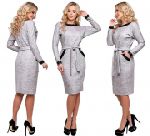
 Buy and download this dress pattern
Buy and download this dress pattern